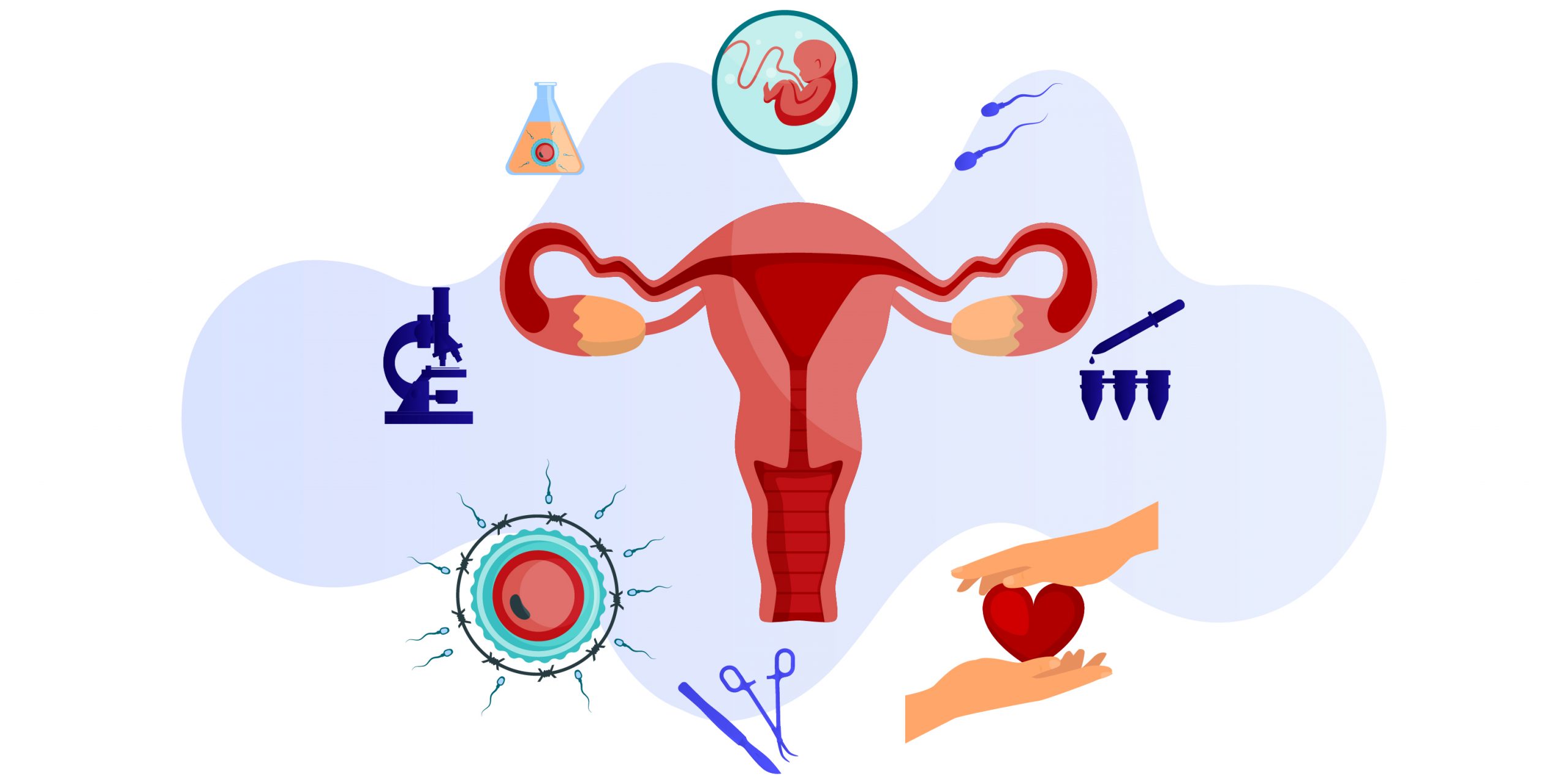INFERTILITY AND IVF
INFERTILITY AND IVF
1- What is Infertility?
Infertility, also known as kısırlık, refers to the inability to achieve pregnancy despite regular, unprotected sexual intercourse for one year.
The prevalence of infertility does not differ significantly between populations, with approximately 15% of couples worldwide seeking consultation from an infertility specialist due to infertility.
In some cases, it is necessary to consult a specialist before the one-year period has passed to clarify the situation:
- If a couple under the age of 35 has been trying to conceive for over 12 months,
- If a couple over the age of 35 has been trying for more than 6 months,
- If a couple over the age of 40 has been trying for over 3 months,
- If previous pregnancies ended in miscarriage,
- If there are psychological or physical issues that prevent the couple from having a healthy sexual relationship,
- If previous fertility treatments have been unsuccessful.
2- CAUSES OF INFERTILITY
The main causes of infertility are as follows:
- Inability to have healthy sexual intercourse between the couple.
- Difficulty or blockage in the union of reproductive cells (egg and sperm) despite healthy and regular intercourse.
- Failure to achieve fertilization even if the reproductive cells can meet.
- Failure of the embryo to develop after fertilization.
- Failure of the embryo to implant in the uterus after development.
- Miscarriage or preterm birth even if the embryo develops normally.
The inability to achieve implantation and fetal development or difficulty in the union of reproductive cells is primarily caused by the inability to produce healthy reproductive cells in both males and females. On the other hand, the failure of implantation despite fertilization may be due to immune or genetic causes.
So, what factors affect the formation of reproductive cells, and what factors prevent pregnancy from reaching term?
The “True Causes of Infertility” are grouped under seven main headings:
- Hormonal dysfunctions
- Anatomical (organ-related) structural abnormalities
- Psychophysiological (psychological and physical) dysfunctions, such as vaginismus
- Infectious (microbial diseases) and toxic (environmental) factors
- Immunological (immune system) dysfunctions
- Hemophilic (bleeding and clotting) dysfunctions
- Genetic (hereditary) dysfunctions
These fundamental causes of infertility manifest differently in men and women. For example:
- Hormonal dysfunctions in women may result in menstrual irregularities, while in men, it may cause sexual dysfunctions like erectile problems or premature ejaculation.
- Anatomical abnormalities in women may appear as tubal blockage, fibroids, or polyps, while in men, it may manifest as varicocele or undescended testes.
- Psychophysiological dysfunctions may result in conditions like vaginismus in women and erectile dysfunction in men.
- Infectious factors, such as tuberculosis or mumps, can cause anatomical and pathological problems leading to infertility.
- Toxic (environmental) factors, like pesticides or chemicals, can also cause anatomical or pathological issues that contribute to infertility.
- Immunological and hemophilic dysfunctions can cause problems with embryo implantation and maintaining pregnancy.
- Genetic dysfunctions can result in recurrent miscarriages in couples.
These underlying causes of infertility must be properly diagnosed and treated to increase the chances of conception.
3- INVESTIGATION OF INFERTILITY
Tests and investigations for infertility causes can be grouped into 2 categories.
BASIC EXAMINATIONS
Basic examinations for the female partner:
If you are undergoing infertility treatment for the first time, NOVA will follow the steps outlined below:

- First, your hormones responsible for egg production will be examined through a blood test, followed by an ultrasound to assess the condition of your ovaries. These tests and examinations will take approximately 30 minutes, and the results will be available in the afternoon of the same day.
- If you have previously undergone infertility treatment without success, or if you have recurrent miscarriages, your doctor at NOVA will likely request more detailed investigations. These may include advanced tests related to the immune system, blood clotting factors, and genetic mutations. When your diagnosis is clarified through these tests, the chances of successful pregnancy will increase. Basic examinations for the male partner:
The main examination for the male partner is a sperm analysis:
To obtain the most accurate result, it is beneficial for you to come to the center after a sexual abstinence period of 2 to 7 days. The sperm cells you provide will be examined under a microscope in the laboratory. The sperm analysis will evaluate the number, motility, and structural (morphological) characteristics of your sperm. You can obtain the results approximately 3 hours after providing the sample. Detailed examinations for the male partner:
If there is suspicion of male-related infertility, and if the doctor deems necessary, further detailed tests and investigations can be performed.
- Scrotal color Doppler ultrasound
- High-speed centrifuge semen analysis
- Testicular biopsy
TREATMENT METHODS
The treatment programs for infertility are ranked from the simplest to the most advanced. Your doctor will determine the appropriate treatment for you by evaluating the factors that are preventing pregnancy.
We can categorize classic treatment methods into 3 main groups:
- Ovulation Induction (Ovulation Therapy)
- Intrauterine Insemination (IUI)
- IVF – Intracytoplasmic Sperm Injection (ICSI)
1- Ovulation Induction (Ovulation Therapy)
The female partner is administered medications that stimulate ovulation, either in the form of oral pills or injections. This stimulates the ovaries and facilitates the process of ovulation.
Who is it applied to?
It is used in cases of infertility caused by irregular ovulation in the female partner. This treatment is applied in cases of mild ovulation disorders when sperm quality is adequate.
2-Intrauterine Insemination (IUI)
The sperm provided by the male partner is processed in the laboratory with special media to separate dead cells and low-quality (morphologically abnormal or immotile) sperm. The healthy and concentrated sperm are then used for the insemination process. Usually, the female partner will also undergo ovulation-stimulating treatment. After ovulation occurs, the processed sperm is injected into the uterus using a thin, soft catheter. If no result is obtained after three attempts of IUI, further advanced treatments are considered. The pregnancy rate is around 10-15%.
Who is it applied to?
Insemination is generally used in cases where there are problems with the cervix, mild issues with sperm count or motility, unexplained infertility, or when no obvious cause is found for infertility in either partner.
DETAILED EXAMINATIONS
Detailed examinations for the female partner:
If infertility is suspected in the female partner, and if the doctor deems necessary, further detailed tests and examinations may be required.
- Hormonal Panel
This includes a series of tests measuring hormones directly or indirectly affecting ovarian function. These tests include FSH, LH, E2, Prolactin, T3, T4, and TSH. Alterations in these hormone levels may have adverse effects on female ovulation. - Laparoscopy (L/S)
In the diagnostic stage (Diagnostic Laparoscopy), the patency of the fallopian tubes, the presence of masses or adhesions in the ovaries, and the overall condition of the uterus can be evaluated. In cases of fibroids or masses, a surgical laparoscopy (Operative Laparoscopy) may be performed to remove them. - Hysteroscopy (H/S)
A very thin optical device is used to examine the inside of the uterus. Through hysteroscopy, conditions that may hinder pregnancy development, such as uterine abnormalities, adhesions, or fibroids, can be directly visualized, and interventions may be performed. - Hysterosalpingography (HSG)
This radiological method, also known as a uterine x-ray, involves the introduction of a contrast medium into the uterus via the vagina to assess any structural irregularities, masses, or fallopian tube blockages. - Sonohysterography
This simple uterine examination method involves introducing saline through the vagina into the uterus using a catheter while monitoring the process with ultrasound. This test can help identify masses like fibroids or polyps in the uterus. It is a valuable diagnostic tool, especially when there are suspicious findings on ultrasound.
-
IVF – Intracytoplasmic Sperm Injection (ICSI)
Ovarian Stimulation and Monitoring of Egg Development; The success of IVF treatment depends on the production of a large number of high-quality eggs in the mother’s ovaries. To achieve this, the ovaries are stimulated with medications that promote egg development. These medications are administered through subcutaneous or intramuscular injections. The ovarian stimulation process lasts approximately 10 days. During this period, the mother’s egg development is monitored with ultrasound several times. If necessary, hormone levels are measured through blood tests, and medication doses are adjusted accordingly.

- Egg Retrieval (OPU); During the monitoring of egg development, when a sufficient number of eggs have matured, hCG injection (trigger shot) is given to complete the final stage of egg development. Egg retrieval is scheduled 36 hours after this final medication. Sedative or sleep-inducing medications can be given during the egg retrieval process, or the procedure can be performed under full anesthesia. The process is similar to the vaginal ultrasound performed during egg development monitoring, except that a needle attached to the ultrasound probe is inserted into the vagina to collect the eggs from the ovaries. The procedure takes approximately 30 minutes. The eggs are fertilized with sperm cells collected from the male partner on the same day as the egg retrieval. After the egg retrieval, the couple is discharged from the hospital after resting for 2-3 hours. The doctor and nurse will inform the couple about the medications to be used after this stage.
- Laboratory Procedures; One day after the egg retrieval, the couple will be informed about how many eggs were fertilized successfully. After this stage, normally fertilized eggs are monitored in the laboratory for 2 to 5 days. The best quality embryos are selected, and a certain number will be transferred back into the mother’s uterus. The couple will be informed about the timing of the embryo transfer.
- Embryo Transfer; Before the transfer, the couple is informed about the number and quality of the embryos to be transferred. The transfer procedure is very similar to a routine examination and does not require anesthesia. The only requirement before the procedure is for the mother to drink water and fill her bladder slightly. This is necessary because the transfer is done under ultrasound observation, and the bladder needs to be somewhat full for better visibility. During the transfer procedure, a catheter containing the embryos is passed through the vagina and cervix into the uterus, and the embryos are placed in the uterus. If there are any remaining high-quality embryos after the transfer, the couple will be asked for consent to freeze and store them for future use.

